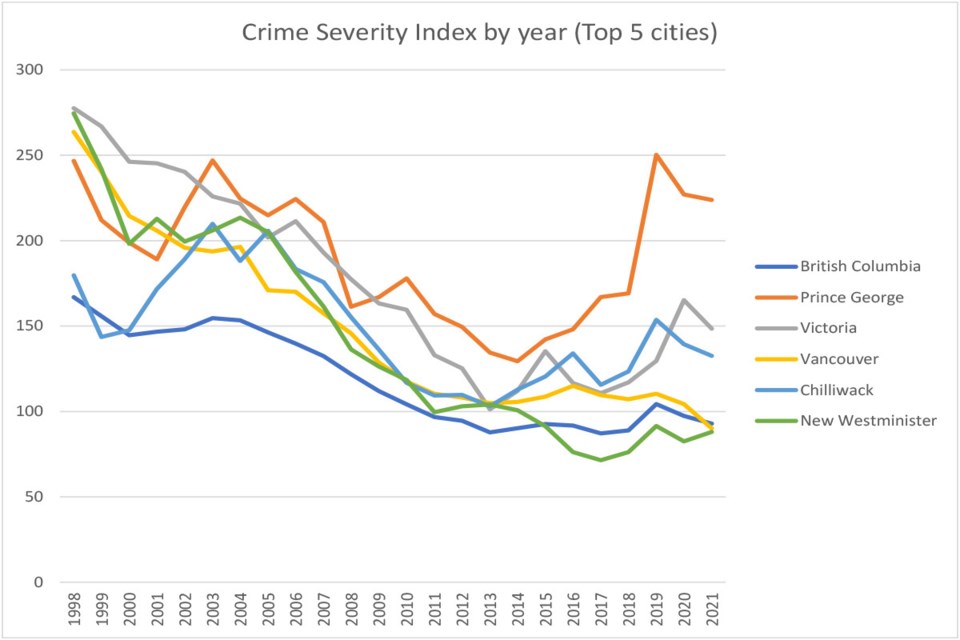Part 2 of an ongoing series
Prince George saw a nearly 80 per cent increase in violent crime in 2019, Statistics Canada and Ministry of Public Safety data shows, and while crime has declined in Prince George since then, it has not returned to the pre-2019 level.
The city’s Statistics Canada’s Crime Severity Index score went from 169.2 in 2018 to 250.16 in 2019. The Crime Severity Index ranks the amount and seriousness of crime in a community, on a per capital basis, against an average score of 100.
According to data released by the B.C. Ministry of Public Safety and Solicitor General, there were 11,849 Criminal Code offences and 714 drug offences reported in Prince George in 2018.
In 2019, there were 19,037 Criminal Code offences (up 60.6 per cent in a year) and 1,106 drug offences (up nearly 55 per cent in a year, despite cannabis becoming legal in October 2018) committed in the city.
Of the 19,037 Criminal Code offences committed in Prince George in 2019, 3,145 were violent offences (including three homicides) and 10,550 were property crimes (including 431 motor vehicle thefts). The remaining 5,342 Criminal Code offences were categorized as “other offences” including disturbing the peace, breeches of probation orders, etc. Violent offences were up 79 per cent from 2018 and property crimes were up 58 per cent, compared to 2018.
In 2020, the city saw 18,237 Criminal Code offences (3,071 violent including one homicide, 10,081 property, 5,085 other) and 775 drug offences. The city’s Crime Severity Index for the year was 227.03.
In 2021, there were 17,016 Criminal Code offences in the city (2,813 violent including six homicides, 10,000 property, 4,293 other) and 506 drug offences. The city’s Crime Severity Index score was 223.92 in 2021.
From 2012 to 2018, the number of Criminal Code offences in the city ranged from 10,229 in 2014 up to 11,849 in 2018.
A Citizen analysis of 24 years of data, from 1998 to 2021, shows that crime across B.C. began trending down in the early 2000s and leveled out at a new, lower level around 2013-14 (with a small bump up in 2019).
Prince George followed the general provincial trend until 2015. After peaking at a Crime Severity Index score of 247 in 2003, the city saw a downward trend in index scores – reaching a low of 129.4 in 2014.
From 2015 to 2018, Prince George’s Crime Severity Index rose steadily each year, up to 169.2 in 2018. Then in 2019, crime in Prince George skyrocketed.
DIFFERENT CITIES, DIFFERENT PATHS
In a previous story, the Citizen reported that Prince George has the highest average Crime Severity Index among B.C.’s 20 largest municipalities, based on 24 years of Statistics Canada data from 1998 to 2021.
Prince George came in first with an average index score of 191.36, ahead of Victoria (176.03), Vancouver (148.95), Chilliwack (148.19) and New Westminster (144.17). But while all five cities were high-crime jurisdictions in the late ‘90s and early 2000’s, Vancouver and New Westminister are now both safer-than-average cities. While Chiliwack and Victoria are both saw spikes in crime in 2019 and 2020, neither are as high as they were in the early 2000s.
Among the 10 similar-size municipalities the City of Prince George compares its wages, council remuneration and taxes against - Victoria, Kelowna, Chilliwack, Kamloops, Naniamo, Delta, Coquitlam, Township of Langley and the districts of Saanich and North Vancouver - Prince George has had the highest Crime Severity Index score since 2010. While Victoria, Kelowna, Kamloops, Chilliwack and Naniamo have seen an upward trend in crime since 2016-17, none have matched the increase seen in Prince George.
Among communities with 5,000 or more people in north and central B.C., Prince George shares similar crime levels to Quesnel and Williams Lake. Prince Rupert, Terrace, Kitimat, Smithers, Fort St. John and Dawson Creek have all seen an uptick in crime starting around 2017, but not to the extent seen in the Cariboo region.





